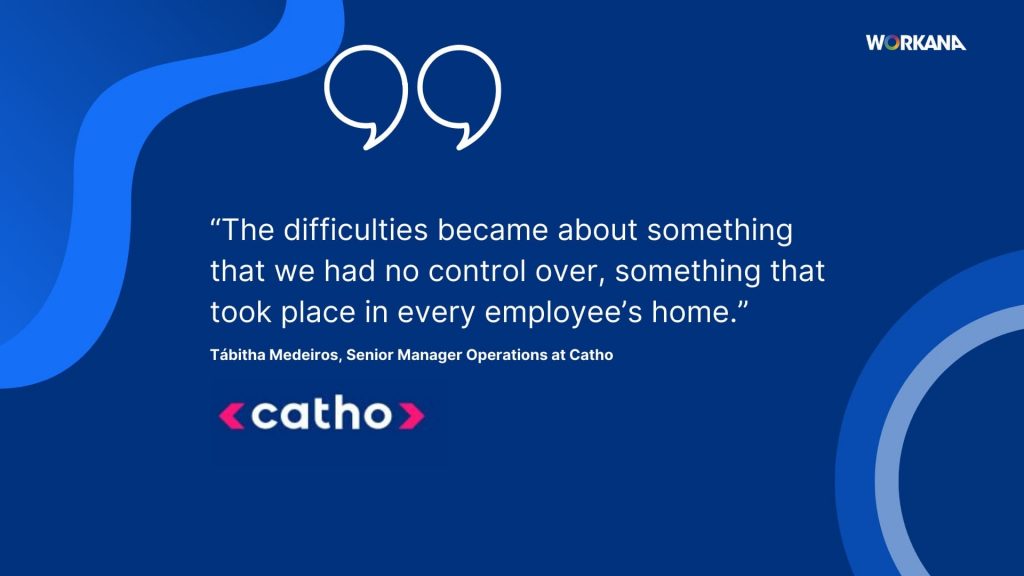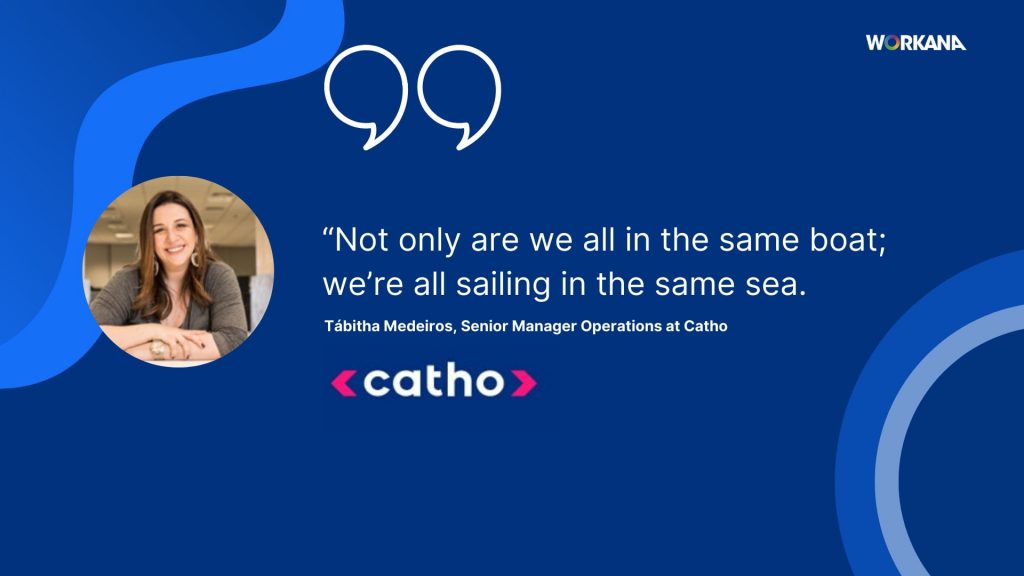It’s said that the digital transformation driven by the pandemic generated five years of progress in remote work. “The challenges have become about something that we had no control over: what happened in everyone’s homes,” explains Tábitha Medeiros, Senior Manager Operations at Catho, a leading Brazilian job posting site. In this article, Medeiros tells us about her experience.
When Catho began implementing remote work policies, it was only a viable option for a few departments. Even though the option was available, few employees used it. “I don’t have the courage to do it; I only do it in my department,” or “What will people think if I’m not in the office?” were some of the concerns that team members voiced.
These ways of thinking didn’t help employees shift their mindsets. But the company understood that little by little, people would see the advantages until they thought of this layout as a different way of working.
With time, the departments that could work from home did so three times a week, and support for remote work gradually increased. This was a change that was still being incorporated and required continuous learning and step-by-step accompaniment, so this process was directed by a consultant specialized in remote work.
Over a year ago, the employees’ initial concerns when they used this method were proving productivity to their managers and leaders, and they ended up working between 12 and 14 hours a day. With practice, consistency, trust, and time, they overcame this fear. Although there are still people who are adjusting.
A six month project completed in one week
The IT teams mobilized at hyperspeed to prepare 370 computers and 100 internet modems for each employee in order to fulfill the teams’ and company’s commitment to achieving a successful result. It was also important to keep each individual’s situation in mind and take their general technical limitations and even family situations into account. Checking internet access, physical space, and available time were key to assemble a fleet of workers ready to work from home in quarantine.

Understanding these peculiarities was the company’s objective, and it was handled accordingly: case by case. They also relied on team members’ collaboration. Team members quickly made everything that they had in terms of infrastructure, computers, internet access, and their homes available. They opened their homes to the company.
Shifts in mindsets for leaders
Letting go of controlling each team member’s minute by minute activity and instead concentrating on productivity was essential. This may seem obvious, but in reality, it’s a very complex change when the team is used to working in the traditional work environment with a less autonomous model. It definitely was an enormous paradigm shift that was impossible to accomplish without changing the leaders’ mindsets.
Changing daily routines that included morning meetings was a challenge. It was essential to understand and revalue face-to-face communication which is important but can also be done with a webcam.
People who had never worked from home before had the idea that working from home was full of benefits without challenges and had to adapt to the reality that working from home isn’t that simple: it requires effort, dedication, and training.
Discipline is fundamental at this time; in order to achieve this result, the company assembled a group of facilitators and points of contact in the company’s most essential departments: for example, people who were helping 24 hour team members with IT matters.

Catho was already using various online resources, like Drive for sharing files to the cloud, for example. Hangout also became a vital tool that made virtual get-togethers and work meetings.
Another important initiative used during the transition was relying on a group of psychologists available to everyone which ended up being an excellent idea because it was well-viewed.
Disruptions in the company Call Center team
The entire Call Center team, both for incoming and outgoing calls began working from home. Making sales by phone, working from home, and doing what worked in order to monitor the processes meant a huge paradigm shift. To achieve all this, good communication was key.
So the company communicated clearly and transparently about the situation which was a historic moment and did everything they could to empathize and understand that everyone was experiencing the same circumstances. Contextualizing what we’re experiencing gives people a shared vision of what they’re experiencing, which is what the company is hoping for and something that everyone can contribute to.

The Catho of the Past is No More
One thing is certain; nothing will be the same as before at any company. It’s very likely that not all employees will return to work at the office full time like they did before. The home office is here to stay. It’s about continuing to learn how to make the most of it.
And training has to be sustainable; training programs centered around training leaders who need to understand which processes need to be improved, what behaviors to promote, and what tools to use so everything works like a well-oiled machine.
A new possibility is presenting itself; more and more people will be chosen based on their people skills and technical skills, and geographic location will no longer be an obstacle to work.
—
You might also be interested in.
- Are you ready to face the new labor pattern?
- Syngenta Shares With Us How They Leveraged Remote Work in Order to Innovate and Prepare for the Future During the Pandemic
- Remote work in risk contexts: How to face COVID19 in the workforce without compromising efficiency
- Teamwork: Identifying Each Member’s Potential
- How to take the first step in using BIG DATA with help from a freelancer
- [Downloadable material] Remote Work Guide





